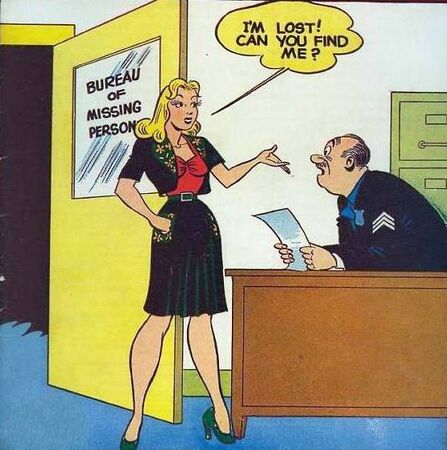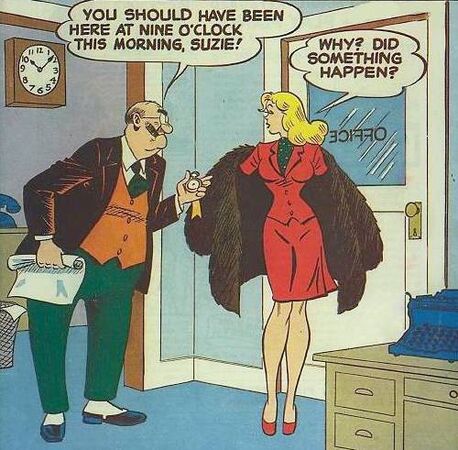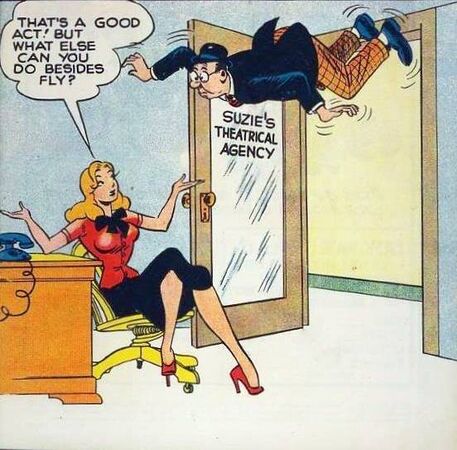Suzie: Difference between revisions
(Created page with "{{italic title}} thumb|right|200px|The August 1947 cover of ''Suzie'' '''''Suzie''''' (Gylic transcription: ''Suzi'') is a Gylian ...") |
mNo edit summary |
||
| Line 33: | Line 33: | ||
''[[Surface]]'' commented that [[Rauna Næsve]]'s portrayal of underemployed and whimsical slackers in her films "owed more than a little to Suzie's own misadventures". The difference was that Rauna was shown as clever, smooth-talking, and irresistibly charismatic — precisely the opposite of Suzie's naïve clumsiness. | ''[[Surface]]'' commented that [[Rauna Næsve]]'s portrayal of underemployed and whimsical slackers in her films "owed more than a little to Suzie's own misadventures". The difference was that Rauna was shown as clever, smooth-talking, and irresistibly charismatic — precisely the opposite of Suzie's naïve clumsiness. | ||
Suzie was embraced as a national symbol | Suzie was embraced as a national symbol, on par with [[Ana (personification)|Ana]] and [[Lisa (personification)|Lisa]], and her status as an icon of ''[[gehenta]]'' contributed to her enduring popularity. ''[[Radix]]'' writes: | ||
<blockquote>"Suzie spends her entire comic being fired from just about every workplace, but we never see her hungry, struggling, desperate for money. Regardless of all her bad luck, she's never worse for wear, and just carries on with casual brightness. This is only possible in a community that looks after people like Suzie, one based on recognising inherent human worth instead of economic worth."</blockquote> | <blockquote>"Suzie spends her entire comic being fired from just about every workplace, but we never see her hungry, struggling, desperate for money. Regardless of all her bad luck, she's never worse for wear, and just carries on with casual brightness. This is only possible in a community that looks after people like Suzie, one based on recognising inherent human worth instead of economic worth."</blockquote> | ||
Latest revision as of 21:05, 24 September 2021
Suzie (Gylic transcription: Suzi) is a Gylian comic series, which was later adapted into an animated series. It was created by Vilmos Vencel, and self-published in the Free Territories from 1945 to 1950.
The series follows the (mis)adventures of good-natured and "not overburdened with brains" heroine Suzie. She was was forever in search of a job and usually managed to get fired from various occupations through ineptness, bad luck, or both. The series gained fame for its saucy humour — which anticipated Vilmos' pin-up cartoons —, slapstick, and satirical commentary on social norms.
The series has been critically and commercially successful, and is considered a landmark in Gylian comics and pop culture. Suzie became an enduring and beloved symbol of Gylian gehenta, an aspect that occasionally attracted foreign commentary.
Plot
In the Free Territories during the Liberation War, Suzie is a young adult trying to make her way in the world. She is sweet and friendly, but very clumsy and naïve, especially about her attractiveness. She is always looking for work but manages to get fired from jobs due to ineptness, bad luck, or both.
Later on the series gains two recurring characters: Ferdie, Suzie's equally dim-witted boyfriend, and Gertie, Suzie's niece, whose saccharine façade conceals her mischievous personality.
Background
Suzie was Vilmos Vencel's first comic series, after years spent drawing pin-up cartoons for civilian publications and contributing to his People's Army training camp newspaper.
The series showcases Vilmos' already characteristic style of innocently risqué humour, embodied in Suzie's inability to recognise her sexual appeal. Some of the best-known comic covers depicted her baffled as to why a crowd of men had gathered around her.
Other main sources of humour included slapstick, usually caused by Suzie's bad luck or cluelessness regarding her attractiveness, and social satire. Vilmos liked to describe Suzie as "not overburdened with brains", and her naïveté allowed her to make humorous comments that contained powerful messages regarding social norms and the human condition. One celebrated example was the February 1948 issue, which shows Suzie visiting a Bureau of Missing Persons and saying, "I'm lost! Can you find me?".
Being published during the Liberation War made the comic's depiction of Suzie as perennially unlucky job-hunter very appealing to Free Territories readers, as it both represented an "oasis of normality" during the conflict and was interpreted through the refusal of work lens championed by Gylian anarchists. Vilmos' wife Nina Campo recalled that they received much fan mail for covers that showed Suzie being impertinent with her superiors, such as arriving late, slacking off at work, or using her work phone to call her boyfriend.
Vilmos struggled with producing and self-distributing the comic. He said the experience made him realise he was better at creating one-liner cartoons than stories. "I started to feel this disappointment that the stories weren't as funny as the covers," he told Cacertian magazine High Society.
Animated adaptation
Although Suzie ceased production in 1950, the comic remained popular. The publication of a Suzie anthology after the Liberation War ended increased the comic's audience, and he was approached for an animated adaptation, which he approved.
The Suzie animated series was produced and aired on GTV1 in 1966–1968, lasting 20 episodes. Jenny Moan provided the voice of Suzie, to significant critical acclaim. Vilmos himself praised Jenny's voice acting, saying that "She didn't play Suzie — she was Suzie."
Reception and legacy
Suzie was a significant success during its run, becoming one of the most popular comics of the Free Territories. Its popularity endured in Gylias, aided by its animated adaptation. It earned critical acclaim for its artwork and writing. The Comics Journal wrote that the comic exemplified "the best tradition of Free Territories comedy" together with the radio series Easy Aces: "a world turned cheerfully upside down where anything seems possible and old certainties are exposed as paper tigers".
Surface commented that Rauna Næsve's portrayal of underemployed and whimsical slackers in her films "owed more than a little to Suzie's own misadventures". The difference was that Rauna was shown as clever, smooth-talking, and irresistibly charismatic — precisely the opposite of Suzie's naïve clumsiness.
Suzie was embraced as a national symbol, on par with Ana and Lisa, and her status as an icon of gehenta contributed to her enduring popularity. Radix writes:
"Suzie spends her entire comic being fired from just about every workplace, but we never see her hungry, struggling, desperate for money. Regardless of all her bad luck, she's never worse for wear, and just carries on with casual brightness. This is only possible in a community that looks after people like Suzie, one based on recognising inherent human worth instead of economic worth."
This aspect has attracted foreign commentary and interest. Internationally, Suzie is mainly popular among left-leaning Tyranians. Some Tyranian right-wing commentators and politicians have used the comic in attacks on Gylian society and red-baiting, holding up Suzie as an exemplar of everything they consider wrong with welfare states.
The refusal of work interpretation of the comics helped them earn popularity among organised labour as well. One pamphlet used Suzie as a comedic guide to industrial action methods, and achieved widespread popularity not just in the GCWUA, but also in the Akashian Sōhyō and the Delkoran LO.






